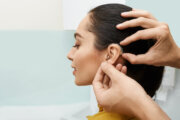When Huawei recently teased a new smartwatch in a promotional video, it featured an unusual design: the watch face flipped open to reveal a secret compartment where a pair of magnetic earbuds sat inside charging.
While the product might only appeal to some users, the inclusion of the earbuds in the smartwatch speaks to a broader trend in the tech industry: With smartphones and smartwatches looking the same from one year to the next, some companies are hoping to gin up excitement among customers with quirky updates to a different, older product line: headphones.
Bone conduction headphones, which rely on sound being transmitted through vibrations on the user’s skull, are gaining popularity. Open-ear earbuds, which similarly don’t block or cover your ears, are suddenly a thing. And one company just launched a $949 pair of air-purifying headphones (yes, you read that right.)
“Headphones are becoming more unique and weirder,” said Sachin Mehta, an analyst at ABI Research.
Multiple factors are driving the trend. For starters, there’s been an evolution of headphone-related technologies, such as noise cancellation technology and built-in wireless capabilities. And unlike with phones and smartwatches, many people have multiple pairs of headphones that they want tailored specifically for different settings and scenarios.
“Now, people own multiple pairs of personal listening products for different locations and use cases; some leave them at the office, others prefer bigger, beefier ones on airplanes,” according to Steve Konig, head of the research department at the Consumer Electronics Association.
Taken together, it affords a little extra room for experimentation.
Bone conduction headphones ‘having a moment’
Bone conduction headphones, in particular, are “having a moment,” Konig said. Rather than sitting inside or on top of the ear canal, bone conduction headphones rest in front of the ear, leaving it uncovered. They transmit audio along the user’s bones and jaw to the ears instead of directly into the ear canal. The headphones also feature a soft band that runs behind the upper portion of the neck to secure them in place and minimize sound distortions.
The exposed ear allows users to pick up on sounds and the environment around them, crucial for safety when doing activities such as riding a bike or jogging. Unlike earbuds, there’s also less concern about it popping out of your ears.
“This [bone conduction] technology has been around for a long time, but it is only more recently bringing benefits to consumer headphones,” said Roberta Cozza, senior director analyst at market research firm Gartner. “The main advantage is the ability to transmit sound without plugging anything in your ear, which means users are more aware of the sound of their surroundings which increases safety.”
She added: “While they look cumbersome, the latest models are very light, and the fit is more comfortable for longer-term wear versus in-ear hearables that can become painful or uncomfortable quickly after a short period of time.”
Although Shokz pioneered bone conduction headphones, a number of brands are now in this market. Beyond consumer appeal, Cozza believes bone conduction headphones could be used by frontline workers who could listen to communications and instruction and at the same time be aware of sounds around them.
“It will be interesting to see how this technology might be used in the future in other wearables, like smart glasses for augmented reality (AR), for example,” she added.
The limits of weird headphones
Open earbuds — such as ones designed by Sony ($180) and Bose ($119) — are also gaining traction. They feature a design similar to bone conduction headphones that leaves the ear canals completely open so that the user can hear the outer noise. But some audiophiles say the sound quality on bone conduction headphones and open earbuds is less than stellar.
For everyday use, people still prefer to buy simple wired earphones or open back and closed back headphones; whereas, for sports, people prefer to buy earbuds because they are easy to carry and fit well inside the ear, Mehta said.
“There are so many unique and out of the box options available in the market — the earwear industry is still untapped when it comes to the use case, which mostly lies around listening and hearing only,” Mehta said.
One of the more off-the-wall concepts, however, comes from household appliances company Dyson, which has famously made headlines with pricey, experimental gadgets (you may remember the $429 hair dryer).
Dyson’s air-purifying headphones aim to tackle the dual challenges of noise and air pollution, particularly in Asia, and may interest people who have certain allergic reactions to pollen or dust. But make no mistake, these do not look like ordinary headphones: the product comes with a face visor that filters and blows fresh air into their nose and mouth.
The design isn’t the only shocker: At $949, the headphones will cost twice the price of Apple’s AirPods Max when it arrives in the United States in March 2023.
“The market for headphones and earbuds is incredibly saturated and even if you stuff every possible feature you can into a pair of these, you still have a device that looks and functions like many others,” said Ramon Llamas, an analyst at IDC. “So how do you differentiate? … Combining it with an air purification system is one company’s approach.”
But with its funky design, Llamas believe it’s not for everyone. “I mean, would you like to be seen in public wearing one of these?”







